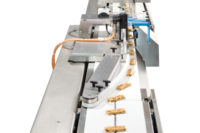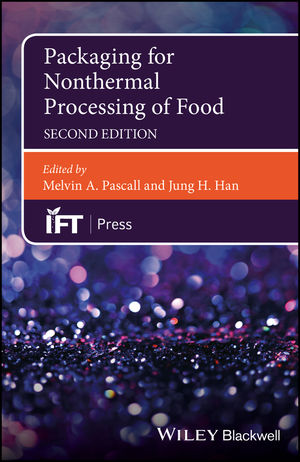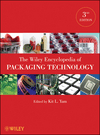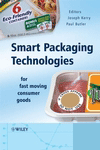Expanding your horizontal packaging horizons
Integrating delta robotics can bring sweet rewards.

 |
| A Delta robot with vacuum cup end effectors gently picks molded chocolate products and places them into the infeed flight of a horizontal flow wrapper. |
Goodbye, struggle. Hello, indulgence. The past few years have dealt us some tough economic times but with the recession slowly fading away, confectionery and bakery brands can finally breathe a sigh of sweet relief. These industries are predicted to have promising market growth: Global Industry Analysts, Inc.'s (www.strategyr.com) 2011 global reports forecast that by the year 2015, the worldwide confectionery market will hit US$186.3 billion and the global baked goods industry will exceed US$310 billion. With both industries’ increasingly optimistic economic mood, sweets manufacturers are eager to grab a piece of that pie and expand market share.
Integrating robotics into confectionery and bakery packaging lines is one effective solution for minimizing direct costs while raising manufacturing output. With robotics, machines perform consistently and can operate 24 hours a day, seven days a week, allowing manufacturers to increase production, which results in a cost-per-unit reduction and a competitive advantage. Because robots are growth enablers, many confectionery companies that initially invest in robotics become repeat customers to expand or upgrade their production lines.
As new advances in Delta robot technology further decrease the total cost of ownership, cost-conscious manufacturers are increasingly automating the feeding of their flow wrappers, as well as the downstream cartoning or case packing of their flow wrapped product. Depending on the application, manufacturers are now seeing a return on investment on robotics in one to two years.
Delta robotics are suited for both upstream and downstream applications of most common confectionery and bakery items, including cookies, biscuits, chocolates, cakes and pastries. An example of upstream, or primary packaging, utilization is incorporating a Delta robot with vacuum cup end effectors for gently picking molded chocolate products and placing them into the infeed flight of a horizontal flow wrapper. Tool-free changeable end effectors facilitate quick product changeovers.
Compared to traditional belt feeding solutions, robotics bring additional benefits, including increased product integrity due to gentler product handling and a higher flexibility with product and pack patterns.
Once the products have been wrapped, manufacturers can also integrate Delta robots for speedy secondary packaging. This top loading technology provides high-speed yet precise picking and placing of single packages into cartons, cases or trays.
With the many end effectors on the market, the key to maximizing overall equipment effectiveness (OEE) is selecting the most appropriate solution for proper product handling. Bosch Packaging Technology offers a full consultancy service for its more than 2,000 end effector designs, ensuring that the correct solution is incorporated into a line.
To further ensure the highest OEE, manufacturers can profit from a supplier such as Bosch who offers a complete multi-level training program for operators and customer support staff. Bosch, as a single source solution provider of robotics for both primary and secondary packaging, is able to equip manufacturers with common components for both production steps. This brings the added benefit of streamlined maintenance and repairs, decreased scalability expenses and lower technology training costs.
About Bosch Packaging Technology
Based in Waiblingen near Stuttgart, Germany, the Bosch Packaging Technology division is one of the leading suppliers of process and packaging technology. About 4 700 associates at over 40 locations in over 15 countries worldwide develop and produce complete solutions for the pharmaceuticals, foods and confectionery industries. Additional information available online at www.boschpackaging.com
Looking for a reprint of this article?
From high-res PDFs to custom plaques, order your copy today!









